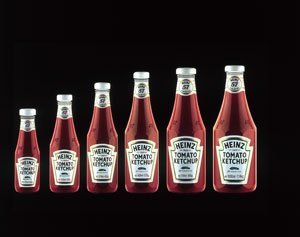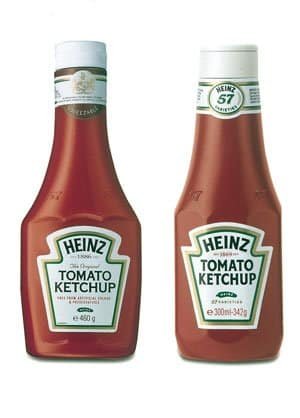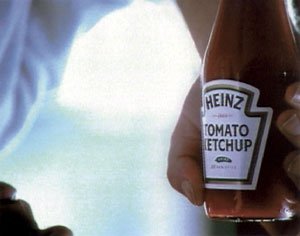
It is easy to think of global products and brand names: Coca-Cola, Mars, and Nestlé are obvious examples in the food and drink line, along with Heinz Tomato Ketchup.
These household brands are not new, they have a long heritage, but the way in which they are marketed has developed in recent years as they have become more focused on the global arena – through global marketing strategies.
This case study concentrates on a good example of a global product. Heinz Tomato Ketchup aims to be the world’s favourite Ketchup on every table. The study highlights the logic of operating globally and examines the 1999 Heinz Tomato Ketchup re-launch.
Tomato ketchup did not become an important Heinz product until the 1880s when the HJ Heinz Company patented the now-famous combination of keystone label, neckband, screw cap and octagonal bottle. It was during the Second World War that the use of tomato ketchup really came to the attention of British consumers as a result of its popularity with American servicemen.
Heinz Tomato Ketchup was first manufactured in the UK in 1946 and gradually became this country’s most popular sauce. Today the UK market is worth more than £105 million and Heinz share is 58%. Search in most food cupboards in this country and you will not have to go very far to find a bottle of Heinz Tomato Ketchup.
Global Marketing

A global marketing strategy involves the creation of a single strategy for a product, service or company for the entire global market, embracing many markets or countries simultaneously and aiming to level differences between them.
Consumers across the globe share many common characteristics. In the 21st century, we will increasingly see the development of a global consumer whether they live in Peking, Prague, Pittsburgh, Perth or Portsmouth. Today, fewer parts of the world are remote and difficult to penetrate thanks to the rapid development of new communications systems. Television, the Internet and other media are able to spread the message about product availability. Rapid transportation and technology transfer links bring products directly to where consumers want to buy them.
The marketing mix for an organisation (product, price, place and promotion) is designed for global consumption. In this way, for example, a standard advertising campaign will be rolled out across television screens around the globe, extolling the virtues of a product that will be identical in every respect regardless of location.
Companies that compete in the global arena are all too aware of the benefits of market leadership. Michael Porter, a business strategist, expresses this in simple terms – ‘gain the lion’s share of the market and the profits will follow’. If you have 51% of the market your next nearest rival can only gain 49%. By winning the largest share of the market you are best placed to benefit from economies of scale – the advantages of being big – enabling you to lower the unit cost of producing items.
On a global scale, clear economies include:
- the ability to mass-produce items using sophisticated technology
- being able to produce a single advertising campaign used in many individual markets
- the ability to bargain from a position of strength when dealing with suppliers
- the advantages of producing a brand that is universally recognised.
Retaining competitive edge

When an organisation produces a highly visible product it is easy to lose the competitive edge by focusing on the present and past rather than looking to the future.
Organisations like Heinz, therefore, have set themselves a challenge for the next millennium – to identify and succeed in winning sectors of the market which they have previously not dominated. It has set out to achieve ongoing growth because the only way to survive and flourish is to grow.
Heinz has set out to bring together its past, present and future:
Present: Heinz Tomato Ketchup is the world’s number one sauce brand.
Past and history: It’s been around for more than 120 years, it’s sold in over 150 countries and it generates more than $1.2 billion in sales. But for all that success it has yet to fulfil its true destiny…
Future: …’ to be the World’s Favourite Ketchup…On EVERY Table!’
The mission now is for Heinz to extend this popularity throughout the globe. Ketchup brings flavour and excitement to so many dishes; from chips and burgers to fish, eggs, steak and chicken. It’s a versatile cooking ingredient and a delicious dip too. The ambitious goal of Heinz is that every time a host food is eaten anywhere in the world, Heinz Tomato Ketchup is no more than 57 centimetres away.
Relaunching the product

Before Heinz can get Heinz Tomato Ketchup onto everyone’s plate, it has to get it onto everyone’s lips. This is why Heinz is engaging in a £32 million re-launch of the product which is designed to:
- make the brand stand for one thing the world over
- reach new users and motivate them in different ways
- make Heinz Tomato Ketchup famous.
The re-launch is designed to give Heinz Ketchup a single voice around the world and to motivate a reassessment of what ketchup is for and the role it plays in people’s lives.
Marketing experts say that the company is trying to reposition its product. The glass fluted bottle is one of the most recognisable Western icons of the 20th century but has never been standardised in every country in which the ketchup is sold. Interestingly, although Henry J. Heinz founded his grocery business that year, his first product was grated horseradish and he did not invent his best-known variety for another seven years.
British bottles had previously carried the date 1886, the year when Henry J. Heinz travelled to London with five hampers of his ‘finest and newest goods’ and sold them to Fortnum and Mason, whose buyer told him: ‘I think, Mr Heinz, we will take the lot.’ The proud boast that the product is free from artificial colours and preservatives is being moved from front to back. Heinz does not use GM tomatoes in its ketchup.
Elements of the relaunch
June 1999 saw the start of the re-launch of Heinz Ketchup which included six key elements.

1. Positioning
In the past, Heinz Ketchup has been positioned to appeal to different consumer groups in different parts of the world. However, as a world brand, Heinz Ketchup will benefit most from a unified positioning and a single set of values. The brand will speak loudest if it speaks with one voice, and the voice Heinz Ketchup will speak with is the voice of the world’s youth – the consumer group which truly transcends national borders. Young people across the globe have embraced modern ideas and consumer patterns far more readily than their parents. It makes sense therefore to win converts in new markets (what the marketer refers to as ‘early adopters’) who will spread the message to others who may be more reluctant to try new products.
‘Some of the Heinz Tomato Ketchup never comes out,’ begins one advertisement. ‘It just stays stuck in there and we can only look at it. This part of the ketchup will never be understood. This part of the ketchup has issues. Heinz Ketchup. Some of it has issues.’
2. Advertising
The new positioning strategy is being supported by a $50 million global advertising campaign that uses irony and humour to reflect Heinz Ketchup’s distinctive, laconic, cool and confident personality. The UK television campaign started in September 1999 and poster sites were also part of the media mix.
3. Usage occasions
Advertising and other communications will encourage a new mind-set about Heinz Tomato Ketchup and the role it plays in everyone’s everyday eating. Promotions with new and traditional host foods will reinforce the message at the point of sale and in the home.
4. Label design
A global brand needs a global visual identity. The many faces of Heinz Ketchup around the world will become one. New label designs have been developed by brand design consultancy Jar (jones Knowles Ritchie). The harmonised designs reinforce the brand’s iconic status with the ideal balance of typography and graphics. The 57 Varieties slogan makes a return to the neck label and there’s a cleaner, clearer back label too.
5. Range
The elements that contribute to the brand’s world-famous design have been extended across all bottles in the new range. Until now the European range has lacked cohesion. Different bottle shapes and diverse label dimensions have served to reduce the impact on the shelf and diffuse the brand’s identity. A completely new range will be introduced to create a close-knit family of 12 bottles (down from 24). The distinctive fluted glass bottle shape is an icon; an instantly recognised hallmark of the real thing in ketchup. A new fluted squeeze bottle was introduced in late 1999, bringing even greater levels of impact and interest.
6. Consumer communications
It is widely recognised that good communications are required to present positive messages about products and their attributes. Heinz Tomato Ketchup has been supported by a well targeted communications strategy that includes:
- Schools football – Heinz Tomato Ketchup is recognised as the premier supporter of English Schools football. The first-ever Heinz Ketchup Cup final was played at Highbury on 17th May 1999 and broadcast on Channel 4 on 5th June. In the year 2000, the brand will expand its support into Scottish and Northern Ireland schools. Research shows that sponsorship is already encouraging a positive reappraisal of the brand.
- Lycopene – There’s more and more evidence to suggest that Lycopene, the substance that makes tomatoes red, has significant health benefits, particularly when the tomatoes have been processed into ketchup, soup and other products. Several studies suggest a link between increased lycopene consumption and reduced risk of heart disease and cancer. Heinz will be investing heavily in research and communications to bring the lycopene message home to consumers. The Heinz Tomato Ketchup neck label, for example, includes the words ‘source of lycopene’.
Conclusion

The six elements of the re-launch of Heinz Tomato Ketchup will bring more value and excitement to the Sauce category than it has seen in a very long time.
As more and more consumers throughout the globe look to branded sauces and other branded products to liven up their eating patterns – then companies like Heinz must seize the opportunities presented by global marketing strategies in order to build a competitive advantage and secure increased global market presence.
